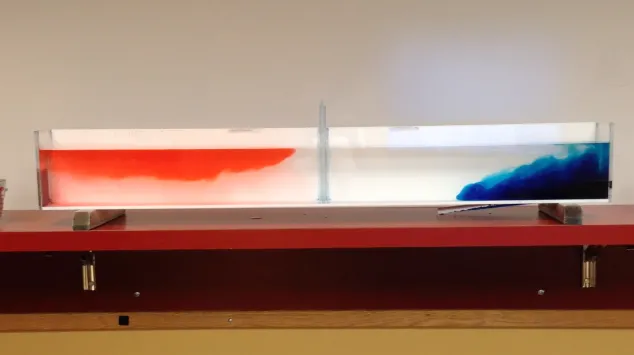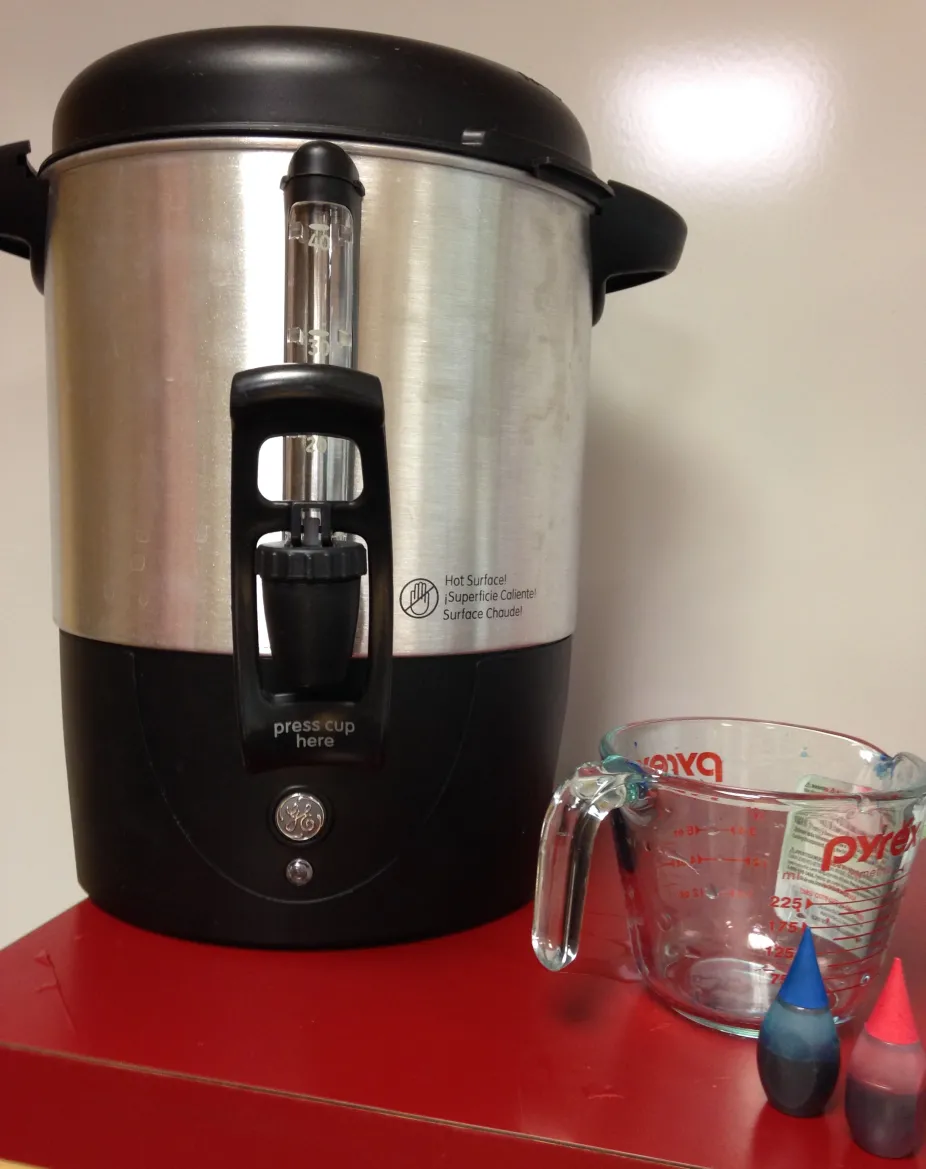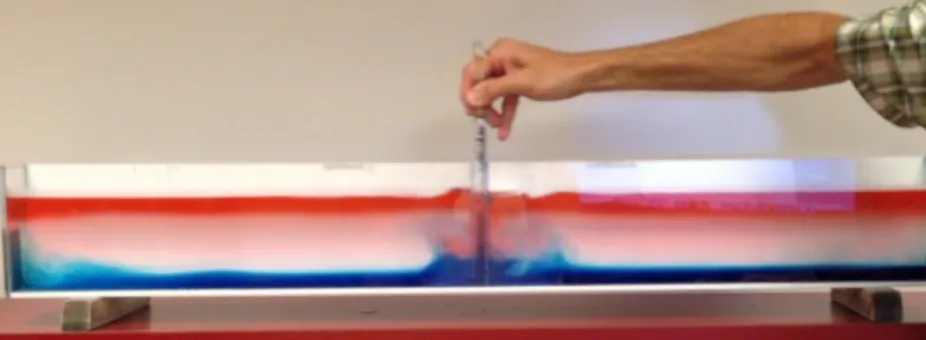Modeling a Weather Front

This demonstration classroom activity can be incorporated into your instruction in two ways: you may choose to set up and conduct the demonstration in your classroom, or you can incorporate the video demonstration provided in the links, along with this classroom activity procedure resource.
Learning Objectives
Students will:
- Be able to explain that water and air are both fluids.
- Be able to explain that warm and cold fluids, such as air, have different densities depending on the temperatures.
- Be able to explain how a weather front model can be helpful, as well as limiting.
- Understand that convection is the transfer of heat in a fluid, such as air and water, by its movement or flow.
Materials

For this activity, you will need:
- A water tank (such as a small fish tank)
- Two pyrex measuring containers
- Water (Three different temperatures)
- Room-temperature
- Ice water
- Warm water (You can use a water heater, coffee pot, or microwave to heat water)
- Blue food coloring
- Red food coloring
- Tank divider (This can be omitted, but it enhances the demonstration)
- Stirring wand
Preparation

- Fill the clear plastic tank halfway with water at room temperature.
- At each end of the tank, place one funnel and one pyrex measuring container.
- If you choose to use the divider, place it in the tank.
- Heat one cup of warm water and add it to one of the pyrex measuring containers.
- Add one cup of cold water and ice to the other pyrex measuring container.
- Place the "wind wand" near the water tank.
Directions
Engage
- Ask students what happens when air is warmed or cooled. (Suggest them to recall the "Bubbles on Bottles" classroom activity if applicable.) Students should demonstrate an understanding that air moves faster when it is warmed and moves slower when cooled.
- Ask students if they can see the air in the room. Tell the students that in this activity, they will observe a model of the behavior of air. If they can't see air, what can they think of to represent air?Tell students that air is a fluid, just like water, but water can be seen.
Explain
Water tank as a model
- Tell students that in this activity, we are going to use a water tank as a model of air in the atmosphere. The water in the tank represents air in the sky, and that in this model, warm and cold water will be used to represent warm and cold air.
- On one side of the water tank, adda few drops of red food coloring to the warm water. Tell students that you are making warm air.
- On the other side, add a few drops of blue food coloring to the cold water. Tell students that you are making cold air.(You may choose to use the "wind wand" to mix the blue food coloring in the water.)
- Ask students to predict which color they think will move faster.Ask for two student volunteers and have them pour the warm and cold water into the tank at the same time.
Weather Fronts

- Have students observe the red and blue colors until the colors reach the divider in the middle of the tank. Do they notice if one color moves faster than the other? What do they notice about the behavior of the red and blue water?(Students should observe that the red layer is higher up in the tank, that the blue layer is on the bottom of the tank, and that the red warm water moves faster than the blue cold water.)
- You may choose to have students draw their observations in their science journals.
- Ask the students what they think will happen when the divider is removed. You may choose to have students record their hypotheses in their science journals.
Convection
- Have students observe as the red warm water extends below the blue cold water.
- Remind the students that the water in the tank represents the larger atmosphere and that it models how warm and cold air behaves in the atmosphere.
- Explain to the students that a weather front is a border between two different masses of moving air with different temperatures and humidity.In general, warm air rises over the cooler air, and it rises at different speeds in different places. Ask students if they think this is a warm or cold front.
-
- Warm Front - A warm front is when warm air moves into an area to replace cooler air.
- Cold Front - A cold front is when cooler air moves into a warmer area.
- Explain to the students that this happens because of convection, which occurs when the sun heats air into motion and causes the weather to change.
Changing weather

- Explain to the students that cold and warm air is moved by high-level winds. Because the water tank is a model, it does not have wind like there is on Earth; and because there is nothing causing them to move the warm and cold layers are distinctly separate. Tell the students that you are going to use a "wind wand" to add energy to the system. This will allow the layers to mix and will model how a warm front can create thunderstorms.
- Have students observe the blue and red colors move in the water tank until the colors are completely mixed.
Note: For more teaching directions for this activity, see the Modeling a Weather Front demonstration video or a similar PDF version of the Weather Front Model activity.
Sense-making
Discuss how the model of the water tank is helpful to understand how convection works. Students may comment on advantages such as being able to see the colors move in the water. Discuss the limitations of using the water tank as a model. Students may comment on the limitation that the water tank does represent all of the factors of Earth as a system, which is why a wand is necessary to demonstrate how wind moves, or that the glass walls limit the natural movement of the red and blue water.
Background
An air mass is a large body of air that has similar moisture (density) and temperature characteristics. A front is a transition zone between two air masses.A cold front is a warm-cold air boundary with the colder air replacing the warmer. As a cold front moves into an area, the heavier cool air pushes under the lighter warm air that it is replacing. The warm air becomes cooler as it rises. If the rising air is humid enough, the water vapor it contains will condense into clouds and precipitation may fall.As the cold front moves, warm, moist unstable air is usually replaced by cold, dry stable air.

A warm front is the boundary between warm and cool (or cold) air when the warm air is replacing the cold air. Warm air at the surface pushes above the cool air mass, making clouds and storms. Warm fronts often bring stormy weather. Warm fronts often form on the east side of low-pressure systems where warmer air from the south is pushed north.A warm front typically replaces cool dry air with warm moist air.
![]()